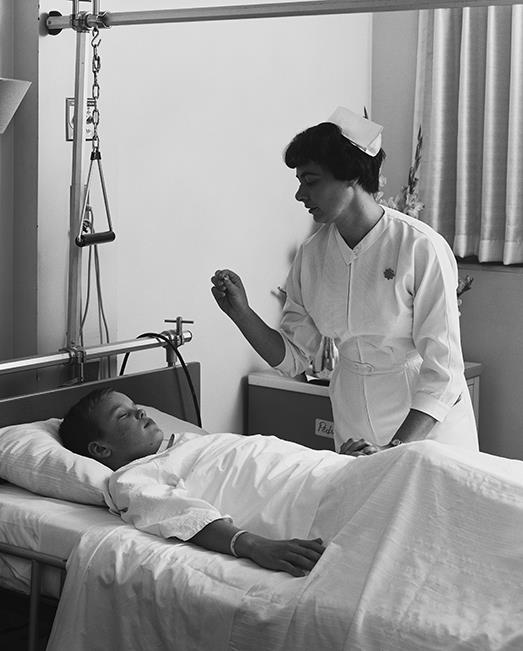Community
Copyright@ Australian Catholic University 1998-2025 | ABN 15 050 192 660 CRICOS registered provider: 00004G | PRV12008
Copyright@ Australian Catholic University 1998-2025 | ABN 15 050 192 660 CRICOS registered provider: 00004G | PRV12008

First, women fought for the right to work. Then, we fought for the right to be professionals. While the concept of ‘the working woman’ is often seen as a relatively new phenomenon (historically speaking), women have in fact been working roles out of the home for hundreds of years. As men built the professions of medicine, law, engineering and accountancy, women were alongside them, becoming professional too.
In the 1960s and 1970s, an emerging class of educated women were frustrated by their exclusion from professions other than nursing and teaching.
Young women started to see those fields as employment ‘ghettos’ for females. Such feminist frustrations were grounded in the real disadvantages women experienced through their schooling and opportunities in the work force.
For historians, however, these frustrations coloured our understanding of women’s role in the professionalisation of the economy, which began in the late 19th century around a hundred years before this ‘second wave’ of feminism.
Dr Hannah Forsyth, senior lecturer in Australian history at ACU, explains how women took control of their own destiny and why the rise of women in professions is important today.
“There are two ways of thinking about it. One is that the nature of the economy changed so that the types of work that people did changed. If you think back to last century most people in Australia would have been working in agriculture or in domestic service. But slowly many of those people started to move to work in factories.
What is not really considered as much is the way that professional occupations like medicine, law, accounting, journalism, teaching and nursing grew from a very small part of that economy to a very large part now. Now days, around 40 to 50 per cent of the economy is professional. In part that is because those professions grew, but it is also because some of the work that people were doing became a profession.
Dentistry, for example, would have been more like a trade in the late 19th century, but became a profession over the course of those years. So, there were two ways of professionalising the economy – one of turning ‘non-professional’ jobs into professions, and another involving the growing demand for new and existing professional roles.”
“In reality, women played a significant role in the economic shift. In 1881, professionals made up two per cent of the male workforce, but five per cent of the female workforce. In the first half of the twentieth century, the percentage of professionals grew – becoming 10 per cent of the male workforce, and 25 per cent of the female workforce. Female professionals accounted for a much larger portion of their respective workforce.
So what 19th century women did was to think about common female roles that they could professionalise, and how they could be part of this changing economy. Nursing and teaching were obvious roles because that is what women already did. So, like dentistry, they turned the things that they were already doing – teaching children and looking after sick people – into paid professional work with standards, ethics and sometimes uniforms. In fact, there were entire economic structures that women managed themselves, lots of schools were owned and run by women as were many, many, private hospitals.
When you read about the history of hospitals in this country you are told there are a few unimportant charity hospitals, and then big public hospitals that are funded by the male philanthropist and led by heroic male doctors. In fact, it was not until the late 1930s that public hospitals took over from the very large number of private hospitals all owned by nurses.”
“Well there are a couple of issues at work. First, the census is not a neutral piece of information. In the late 19th century the people producing the census had an agenda – they wanted to create a standard ‘living wage’ for males, and they wanted that living wage to be high enough to cover a family. To do that, they needed to keep the number of working women in the census low. That’s one of the reasons why professional women account for a much higher proportion of women in the workforce than men – because a lot of the work women were doing was not counted in the census at all.

The other reason is the massive growth of hospitals and schools. That is not something we have given a great deal of thought to before in the professionalisation of the economy. You look at the economy and think about industrialisation, manufacturing, etcetera and the theory is that the increasing complexity of the industrialising economy leads to accountants, engineers and lawyers because of the complexities of enterprises. That is not untrue, but hospitals and schools were growing much faster than any of those things because of the introduction of compulsory education in the late 19th century, an increased number of unwell people (due to living in industrial cities and working dangerous roles) and scientific learnings around health.”
“There are two factors at play – sex and class. Race is also important. It’s true in many ways the system was run by men for men, but disadvantage has layers. For example, white middle-class women were much less disadvantaged than other groups of women and plenty of men, too – think about the lack of opportunities available to Aboriginal or Chinese men in the late 19th century. When we think of disadvantage, I think it is best not to just split it into men are winners and women are losers. For example, while women were underrepresented in professions such as law and engineering, so were most men. So, you have to think about class and race as well as gender.
Within the middle class, women were disadvantaged, however. All work was so profoundly gendered as residue of older, middle class norms. In an earlier economy people worked in or near the family home, perhaps a home with a workshop or farm attached. But as factories developed, people went to work away from home.
More often it was ‘male type’ jobs that were located away from home at first. That created the assumption that work was a male thing ‘out there’ and domestic life was a female thing ‘in here’. The residue of that has stayed around for a long time – even today.”
“When we are trying to design things like education programs or equity programs, we need to remember that class, race and gender are at work. For example, to think that having more women engineers is success – well, it is not that great a success if all it is doing is privileging another group of white middle-class women who have already done pretty well for themselves. It matters to think about equity from multiple perspectives, and to use our understanding of the economic history of work to help us to do that.”
Dr Hannah Forsyth is a senior lecturer in Australian history at ACU. She is the author of A History of the Modern Australian University.
Learn more about ACU.
Copyright@ Australian Catholic University 1998-2025 | ABN 15 050 192 660 CRICOS registered provider: 00004G | PRV12008